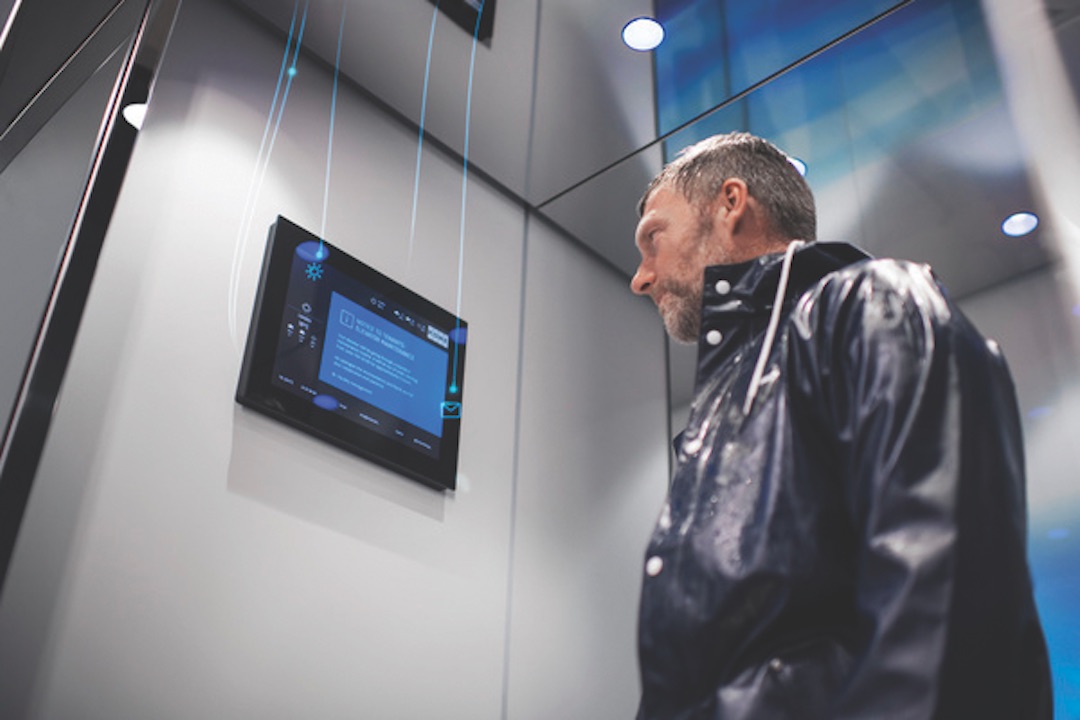KONE Corporation has announced a new elevator technology that could make it possible for supertall buildings to reach greater heights by eliminating several problems of existing elevator technology. The firm's new UltraRope hoisting system uses a rope with a carbon-fiber core and high-friction coating, rather than conventional steel rope. UltraRope is comparatively lightweight, requiring 15% less energy for moving hoisting ropes, compensating ropes, counterweights, elevator cars, and passengers, according to KONE.
In addition, carbon fiber resonates at a different frequency than steel and other typical building materials, a property that is predicted to reduce downtime attributable to building sway. KONE estimates that the product will only have to be replaced half as often as steel rope. The manufacturer claims that the new technology will make it practical for elevators to travel heights of up to 1,000 meters—twice as high as is possible with current technology. (Elevators in the Burj Khalifa, an 828-meter-tall building, will travel a maximum of 504 meters.)
The technology could help facilitate the creation of high-density housing and other urban projects. "This is finally a breakthrough on one of the 'holy grail' limiting factors of tall buildings: that is, the height to which a single elevator could operate before the weight of the steel rope becomes unsupportable over that height," says Antony Wood, Executive Director of the Council for Tall Buildings and Urban Habitat.
(http://download.kone.com/ultrarope/index.htm)
Related Stories
| Nov 11, 2013
4 trends driving the recovering commercial construction sector
Jones Lang LaSalle research reveals a four-point “new look” for the post-recession construction industry.
| Nov 8, 2013
Oversized healthcare: How did we get here and how do we right-size?
Healthcare facilities, especially our nation's hospitals, have steadily become larger over the past couple of decades. The growth has occurred despite stabilization, and in some markets, a decline in inpatient utilization.
| Nov 8, 2013
Can Big Data help building owners slash op-ex budgets?
Real estate services giant Jones Lang LaSalle set out to answer these questions when it partnered with Pacific Controls to develop IntelliCommand, a 24/7 real-time remote monitoring and control service for its commercial real estate owner clients.
| Nov 8, 2013
S+T buildings embrace 'no excuses' approach to green labs
Some science-design experts once believed high levels of sustainability would be possible only for low-intensity labs in temperate zones. But recent projects prove otherwise.
| Nov 8, 2013
Net-zero bellwether demonstrates extreme green, multifamily style
The 10-unit zHome in Issaquah Highlands, Wash., is the nation’s first net-zero multifamily project, as certified this year by the International Living Future Institute.
| Nov 8, 2013
Walkable solar pavement debuts at George Washington University
George Washington University worked with supplier Onyx Solar to design and install 100 sf of walkable solar pavement at its Virginia Science and Technology Campus in Ashburn, Va.
| Nov 6, 2013
PECI tests New Buildings Institute’s plug load energy use metrics at HQ
Earlier this year, PECI used the NBI metrics to assess plug load energy use at PECI headquarters in downtown Portland, Ore. The study, which informed an energy-saving campaign, resulted in an 18 percent kWh reduction of PECI’s plug load.
| Nov 5, 2013
Net-zero movement gaining traction in U.S. schools market
As more net-zero energy schools come online, school officials are asking: Is NZE a more logical approach for school districts than holistic green buildings?
| Nov 5, 2013
New IECC provision tightens historic building exemption
The International Energy Conservation Code has been revised to eliminate what has been seen as a blanket exemption for historic buildings.
| Nov 5, 2013
Living Building Challenge clarifies net-zero definitions and standards
The Living Building Challenge has released the Net Zero Energy Building Certification to provide clearer definitions regarding what net zero really means and how it is to be achieved.


















